Arriba/Abajo (Up/Down)
WAYS WE CAN USE THE WORD
TO EXPLAIN: i.e., Los regalos están arriba de la mesa. (The presents are on top of the table.)
TO REQUEST: i.e., Pon los libros arriba de la mesa. (Put the books on top of the table.)
TO SHARE INFORMATION: i.e., Las tortugas viven bajo el agua. (Turtles live underwater.)
TO COMPLAIN: i.e., No quiero ir arriba de la escalera. (I don’t want to go up the ladder.)
For specific questions or more ideas regarding this core word activity sheet, please contact Sofia Ortiz @ fortiz1@mail.sfsu.edu. Thank you!
Circle: During circle time sing a new good morning song.
Morning Song in Spanish:
(Child's Name Twice) Salta arriba y abajo
Dale la vuelta
Actúa como un payaso (Child’s name twice)
Salta arriba y abajo
¡Ahora siéntate de nuevo!
Morning Song in English:
(Child’s name twice) Jump up and down
Turn all around
Act like a clown (Child's Name Twice)
Jump up and down
Now sit right back down!
Here are some examples of children’s welcome songs in English which you can use as inspiration.
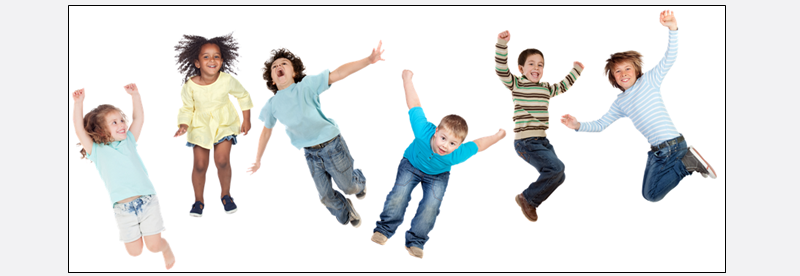
Toys and Games: During free choice, students can play with legos, blocks, magnetic building tiles, or any other manipulatives of their choice. They can stack them on top of each other or create structures. Adult can ask the child “cual lego esta arriba y cual esta abajo? (which lego is up and which lego is down?)
Recess: During recess students can take toy balls and cars. They can then push the toys down a slide. Adult can model to the student and say “empuja la pelota abajo del tobogán” (push the ball down the slide.)
Students can also play hopscotch or in Spanish we call it “la rayuela.” Adults can model the rules to the students and say, “vamos a saltar arriba en la siguiente casilla.” Encourage students to say outloud the number they are jumping on.
Here are some suggested books on YouTube that can assist in teaching the core word:
- ARRIBA Y ABAJO - cuentos para niños en español - cuentos de amistad
- In this book the core words arriba y abajo are mentioned several times throughout the story, and adult can point to the characters and ask the students, ¿En qué dirección va el pingüino, hacia arriba o hacia abajo? (which way is the penguin going up or down?). It’s beautiful story of friendship, perseverance and pursuing your dreams. Written and illustrated by Oliver Jeffers.
- Audiolibro 'Arriba, abajo... escarabajo'. Un cuento sobre el valor desconocido de los insectos.
- Audiobook “Arriba, abajo... escarabajo” The fable tells the story of a beetle that, like Sisyphus, tries to climb up the slope with its coveted fertilizer ball, coinciding on the way with all kinds of insects that fulfill their function. This book features the core words arriba and abajo on almost every page.
- Arriba, Abajo Y Alrededor
- This book is narrated in Spanish and features text in Spanish with the core words arriba and abajo on nearly every page.
ARRIBA - ABAJO PARA NIÑOS DE INICIAL - CLASES VIRTUALES
In this video Miss Maria gives students a lesson on arriba y abajo. She presents multiple common objects and asks students if they are typically found up or down. When the common objects are combined they create a picture of a child at a park on a sunny day. She explains that objects can go up and down and do not stay in a definite position.
As a gross motor activity students can stomp their feet on the ground. The adult can ask ¿Dónde están tus pies? (where are your feet) to which the students will respond abajo (down). You can ask this question with other body parts such as: head, hair, nose, toes, knees, legs, calves, ankles, ears, etc.
Another gross motor activity is to do have the students do some stretching. The adult will tell the students to “estira los brazos hacia arriba y estira los brazos hacia abajo” (stretch your arms up and stretch your arms down.)
- CUENTO INFANTIL ARRIBA-ABAJO
- Animated short story that features the core words arriba and abajo several times throughout the story.
- Arriba y Abajo | Nociones espaciales para niños | Dinámicas virtuales Divertidas ❤️🎶😁
- Song that features the core words arriba and abajo in nearly every verse of the song.
Adults can support students as they complete the activity sheet found here.
These educational activities can be used in classes as well as at home to teach and reinforce the learning of your children. You will find educational images that will facilitate your child's learning, we are sure that it will be of great help and you will love having this support material.
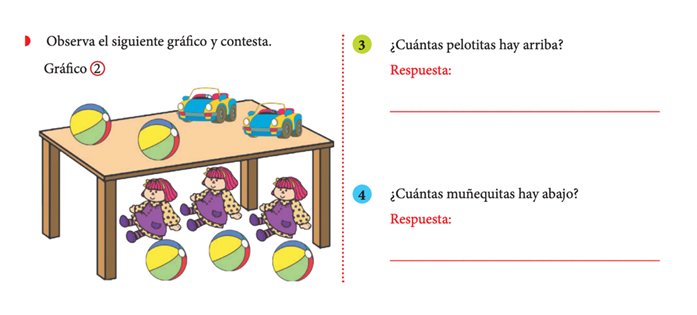
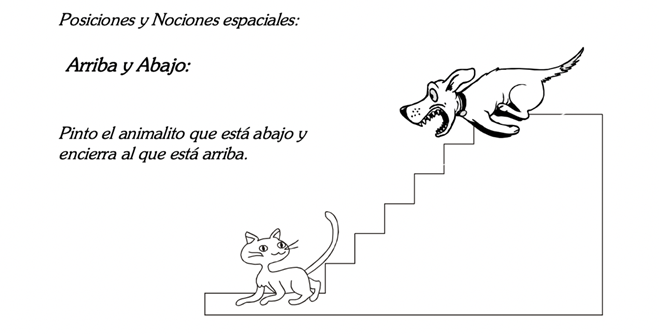
Activity sheet ideal for students from 3 to 5 years of age that teaches spatial awareness. Ask you student to, “Colorea al niño en la imagen que está arriba en amarillo y colorea al niño que está abajo de rojo.” (Color the child in the image that is up yellow and to color the child that is down red).

Give the student a balloon. Either have the child blow up the balloon on their own or assist them. Once the balloon is blown up have them decorate it with markers, stickers, glue feathers or googly eyes. When they are finished decorating their balloons, ask the children if they think the balloon will float up or down i.e., ¿Crees que el globo flotará hacia arriba o hacia abajo? (do you think the balloon will float up or down?) Have the students perform their experiment. Explain to the students that only balloons filled with helium can float up i.e., Solo flotan arriba globos llenos de helio (only balloons filled with helium float up).
This website gives lots of great DIY options on how to decorate a balloon.

Ciencia100 | Globos que flotan sin helio - Experimentos divertidos
This video teaches you how to make balloons float without helium.
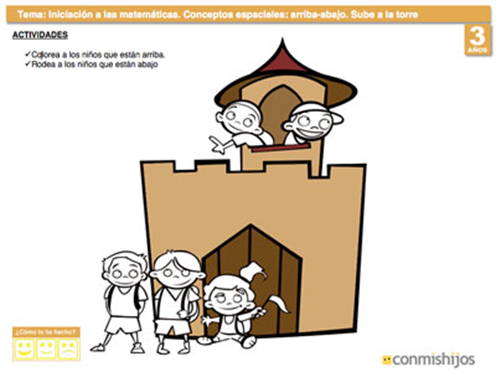
Math worksheet to teach students spatial concepts such as up and down. Print of this activity sheet for the student and have them color the children that are up and circle the children that are down. The goal of this activity is to differentiate spatial concepts up and down.

Teach students spatial concepts up and down with this image of a tree. Show this image to the student and ask them, “¿Dónde están las raíces del arbol arriba o abajo? (where are the roots on the tree up or down?)
Play a multiple choice questionnaire game with time limit, timelines and a bonus round. This is an interactive game that teaches students the core words arriba y abajo.

This game gives students 30 seconds to identify and select which object is up or down out of a field of six. There are five total questions in this game.
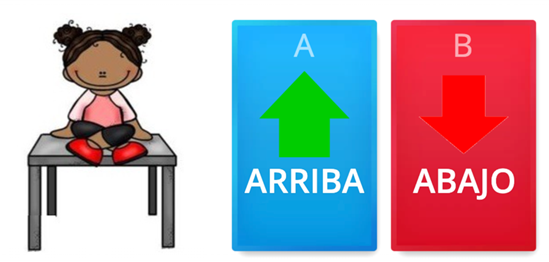
This game gives students an unlimited amount of time to identify and select whether a given object is up or down out of a field of two. There are eight total questions in this game.
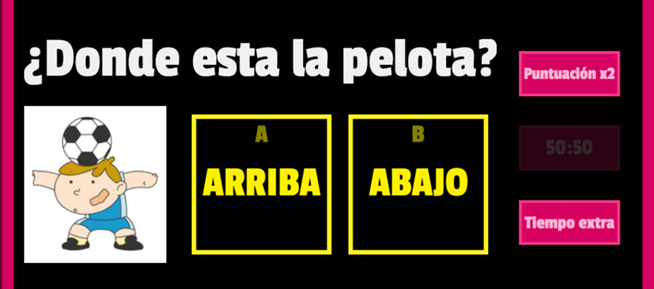
This game gives students 30 seconds to identify and select whether a given object is up or down out of a field of two. There are seven total questions in this game.
WORD WALL: Create a WordWall and add ‘core word in bold’ to the list.
READING and the Word Wall: Sound out the letters together. Have the students find the word on the AAC system.

WRITING and the Word Wall: Using a pencil or alternative pencil, have students
try to type the word on the keyboard or write the word together.
Choosing Words for the Classroom Word Wall with Dr. Caroline Musselwhite Video: Courtesy of Edmonton Regional Learning Consortium.